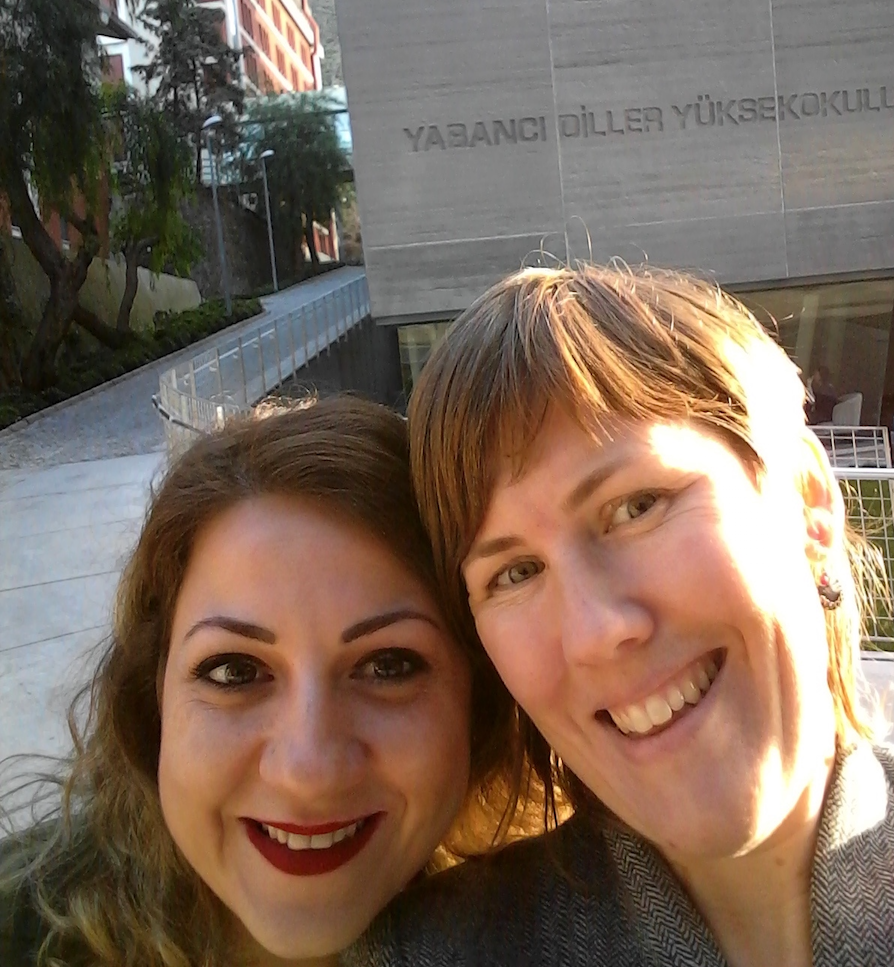
International Conference on Educational Theory and Research
Review by Amy Stopper-Uzunkoca & İlkem Kayıcan
1st International Conference on Educational Theory and Research took place in İzmir from 11-13 February. Compared to a typical ELT conference, it was different in terms of the themes it addressed. The presentations covered a wide range of interdisciplinary topics including anguage learning, design, engineering, science, mathematics and more. The focus of the all themes aimed to offer new developments, technologies and approaches at both the national and international level. The conference had 5 plenary speakers and nearly 50 concurrent sessions.
Our Presentation & Paper:
“Bridging the Gap between Preparatory Classes and Freshman Courses in Higher Education”
We introduced the integration of a new component into a preparatory year course that allows students to both develop critical thinking and academic writing skills, and cope with social science freshman courses at university level. As today, in most European countries, a significant increase has been observed in English medium universities which generally convey knowledge using a Western discourse pattern, when asked to cope with academic writing which requires bringing multiple skills together such as researching, reading, annotating, critical thinking, analyzing, corroborating different resources and referencing, a considerable burden is placed on students’ shoulders. Thus, in order to fill the “gap”, and allow preparatory year students a smoother and more substantial transition to freshman courses, the Foundation Development Year features a separate course entitled Critical Thinking for Social Sciences (CTSS). In our study we detailed the CTSS course method, described its implementation into the preparatory year program and shared the results of feedback collected from students who took CTSS during the last academic year and who were currently taking Social and Political Science.
In our research we canvassed students through a combination of questionnaire and semi-structured interviews. Respondants observed similarities between CTSS and SPS in terms of using visual source evaluation to come to conclusions on a historical era. They also felt that the way citical reading and academic writing skills were used was similar; however, CTSS’ topic of Roman gladiators/society was not seen to be a common with SPS. These views suggest that learners have more opportunity to strengthen academic skills than build a connection with the content. Similar viewpoints were expressed when respondants said how CTSS had helped them cope with SPS and other freshman courses. When asked how CTSS could better support learners of SPS, we saw that while students saw that Rome was part of SPS content, they felt the need of a broader historical knowledge.
Just after our paper was submitted, we tripled our participant count to around 120 responses. Apart from adding further validation to the study, we are happy to say that these responses confirmed the above conclusions.
For our full paper: https://globalelearningjournal.files.wordpress.com/2010/11/03-kayican.pdf
Concurrent Sessions – a sample.
“Cognitive Profiles and Learning with Computers”
Arif Altun, Hacettepe University
The plenary talk by Altun particularly attracted my attention as we have been passing through a digital transformation in educational methods and components for the last 20-30 years. In his talk Altun addressed a quite important question: whether “multiple designs for one” or “one design for all” is an ideal model when learners’ cognitive characteristics are considered. The trend of “designing personalized learning environments” is quite a challenging task because different personal characteristics change when exposed to various media and design choices.
Altun proposed different neuropsychological tests and outlined otheir potential uses in determining cognitive profiles. His argument about the design of a learning model was highlighted in these 3 key points:
1. Design can fail a student or vice versa.
2. Context (whatever it is) might make a difference
3. Each learning is unique and personal!
Altun mainly wanted to raise awareness of the fact that whatever digital design you come up with for learners, their cognitive processes may produce very surprising results other than the designer expected. For this reason he argued that “if we need to train future teachers in a digitized world, it would be essential to understand how technology, especially computer technology is shaping us!” and emphasized that “more objective and self-report tools are to be utilized”. Finally, Altun underlined the importance of design when integrated with technology, referring to Davie and Inskip (1992): “good instructional design is more important than the specific technology”, and he warned the audience that online courses should be designed when one knows the learners well.
“The World is My World: An Exploration of the 21st Century Language Learner”
Havva Kurt Taspinar, IZTECH
Through this study Taspinar aimed to discover student perceptions of what “a language” is, who “a language learner is” , and how vital it is to learn English in 21st century. Taspinar introduced the overall picture of 21st century learner identity, and argued that the skills included for such a learner include problem solving, creativity, computer litearcy and communicative skills. It personally made me glad that in SL we have done a lot to address these skills.
In her study she asked participants these five questions:
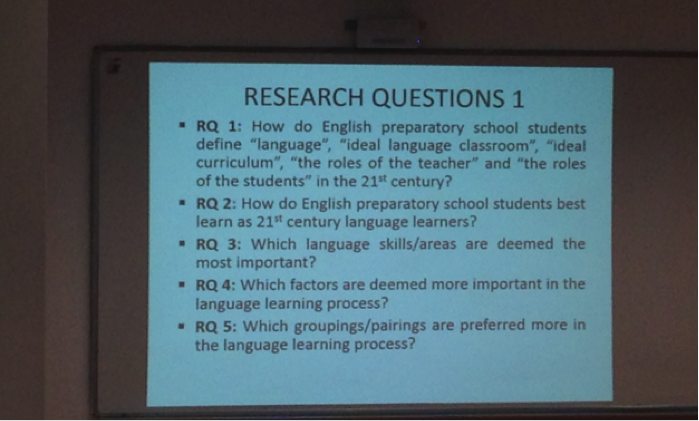
Her findings indicate that learners consider English as a communication tool that enables them to have a different perspective, and express their feelings, thoughts and behaviors. When it comes to the role of the learner according to students’ perceptions, the findings are interesting since they address most of the fundamental ways to learn a new language, such as recycling what they learn and find ways to practice them, and being as active as possible for permanent learning. The most impressive response mentioned the key role of the learners themselves, “%60-70 of the responsibility belongs to the student. The student who knows what s/he wants can learn the language in a very short time.” I hope such an approach will spread in the near future. In terms of the learners vocabulary, knowledge is the most important factor in language learning. For learners the ideal language classroom should have variety of different characteristics which you can see in the following slide:
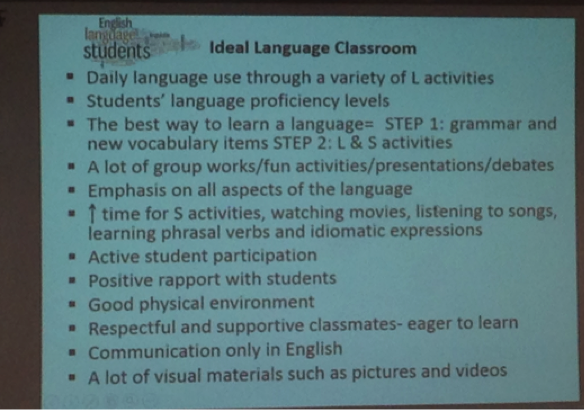
“Flip the page: reinvigorating Literature in the Classroom through Flipped Learning”
Eric James Beyer & Jonathan Mark Day, MEF University
Literature courses are by nature “flipped” in that students are required to complete readings before contact with the instructor. In order to create in students a sense of ownership, their contributions are placed at the centre of the course. Before class learners post to a padlet a media item they would like to discuss in class, which the instructors worked before class to incorporate into the lesson. When students saw their content utilised in class, they thus responded much more.
Furthermore, learning outcomes are designed to engage learner opinion and have them work actively and creatively with it: they are required to research, plan and actively engages in formal debates, opinion essays and presentations.
“The Effects of Applying CT Skills on EFL Medical Students’ Argumentative Writing”
Zahra Shahsavar, Shiraz University of Medical Sciences
Naturally as a CTSS instructor, I jumped at the chance to attend this session. Ms Shahsavar’s students needed to develop critical thinking skills for their thesis writing, and she detailed the method and research she carried out to evaluate its effectiveness. As it was necessary to scaffold the students step by step towards thinking critically, Ms Shahsavar followed the Duron model of CT; below is an example:
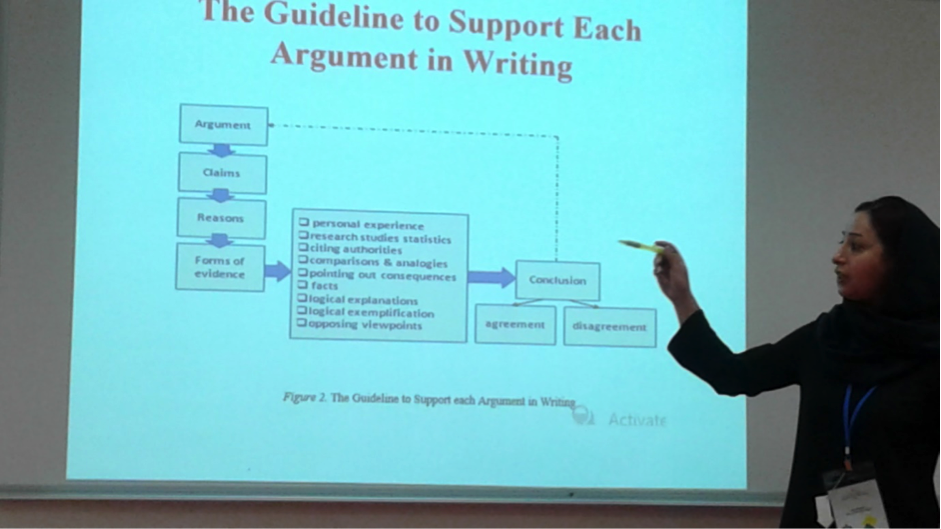
In terms of marking CT writing, Facione & Facione’s Holistic CT Scoring Rubric (2014) is used. For research, she used the Cornell Critical Thinking Test Level X adapted from Ennis et al. (2004). Her key findings were:
• training in CT can enhance learner’s argumentative writing
• direct instruction and guidance from instructors is necessary for a learner to develop CT
• learners need information on why CT is important
We chatted a lot with Zahra after her session, also to tell her about CTSS since she was unable to stay for our presentation, and we are now looking for possible ways to collaborate!
“Whose Responsibility is it in Higher Education to develop undergraduate students’ notion of democratic citizenship?”
Rhian Webb & Troy Sarina, Macquarie University
The Council of Europe’s 2006 Call for Action was to develop young people’s notion of being a democratic citizen and Ms Webb described how one degree course decided to implement this:
• Course outcomes should be covert to avoid putting students off (NB. voting apathy in Australia necessitates a fine for non-voters!)
• Lesson activities: debating, guided enquiry (scaffolding research) involving students in activity design
• Peer assessment to teach more democratically
• Following Literary Third Space theory: the “space” between the knowledge learners bring with them and that of academia
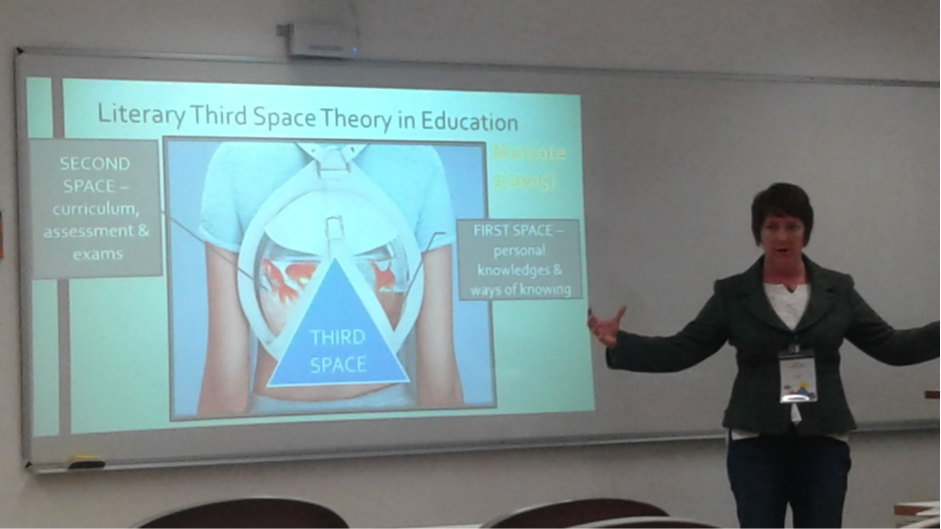
“Education, Damnation, Revolution: Autonomous Models of Art Education as resistance to Neo-Liberalism”
Richard Miles, Leeds College of Art/London Graduate School
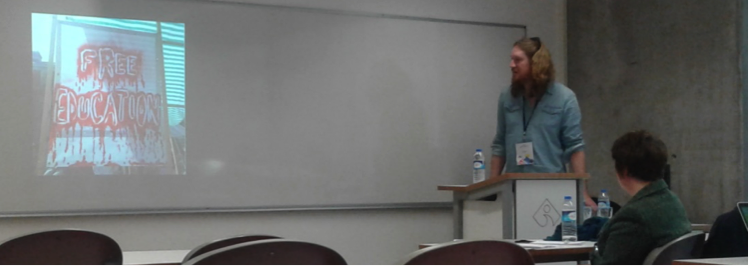
The School of the Damned is a free arts school in the UK providing (possibly) a masters-equivalent education. Opened in response to UK cuts to education and the arts, and the exponential rise in the cost of attending a UK university, the school aims neither to be part of capitalism nor maintain the status quo. Some of the principles particularly revolutionary were:
• “Gift economy” or “time bank” system – the time lecturers spend at the school is compensated by students working for the same amount of time on lecturers’ own projects
• Student-elected faculty - annually students themselves are the ones who invite artists to work at school as “tutors”.
• Student-centred model of education - the school tries to side-step the teacher-centred model of education, avoiding the division of knowledge into those who know and those who don’t:
“It is the explicator who needs the incapable, and not the other way round.” Jacques Ranciere, 1818
